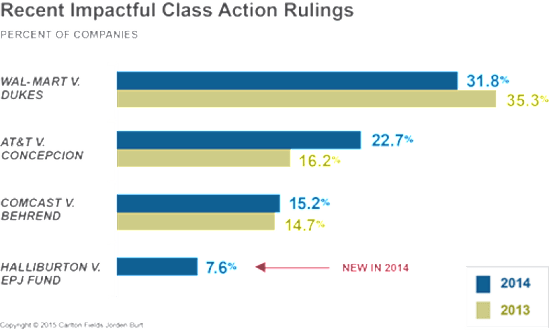SCOTUSblog previews this month’s Supreme Court oral arguments in Campbell-Ewald Co. v. Gomez, a case that could allow the court to dramatically limit the availability of class action lawsuits.
“The issue is so simple it is surprising there is no answer: if a defendant offers to pay the plaintiff everything the plaintiff could get if the plaintiff wins, does the plaintiff have to take ‘yes’ for an answer? Phrased that way, you might think ‘yes’ is the obvious response. But if that is correct, then class action defendants have an easy way to avoid class certification by simply picking off the named plaintiffs as they appear.”
“The case involves a class action under the Telephone Consumer Protection Act, which prohibits a wide variety of formerly common telemarketing activities; the statute provides for statutory damages of $500 but not attorney’s fees. Promptly after receiving the complaint, the defendant – petitioner Campbell-Ewald Co. – made an offer of relief of $1500, three times the statutory damages that respondent Jose Gomez (the named plaintiff) would receive if he ultimately prevailed. The question whether that offer is enough to vitiate Gomez’s claim raises foundational questions about class actions. From the perspective of defendants (in class actions or otherwise), it is crucial that there be some way to end litigation. If the defendant wishes to concede and to pay a full recovery, hasn’t the purpose of the lawsuit been completely served?”
“The central strategy chosen by Jonathan Mitchell (the former Solicitor General of Texas, representing Gomez) is to pound repeatedly on various logical difficulties of Campbell-Ewald’s position. Most obviously, if the offer itself moots the case, then how can the court enter judgment at a later date? Similarly, how can a settlement offer that is rejected be binding as a resolution of the case; a rejected contractual offer has no binding effect, even on the offeror. Again, there is something deeply unsettling about a district court forcing acceptance of an offer by entering judgment in favor of the objecting plaintiff.”
Alison Frankel highlights the three cases involving class actions that the Supreme Court has agreed to hear so far this term. Her conclusion: “If all goes the way defendants hope, by the end of next term they will have eliminated class actions based on statutory damages in federal consumer laws, fenced liability in cases involving plaintiffs with a mix of injuries and entrenched a tactic for squelching class actions cheaply.”
And the chart below from the 2015 Carlton Fields Jorden Burt Class Action Survey shows that “Recent class action rulings continue to benefit class action defendants.”
“The 2011 Supreme Court case, Wal-Mart v. Dukes, which was cited by nearly 32 percent of in-house counsel, still has the greatest influence on class action management. It increased the level of scrutiny given to each class action, requiring courts to engage in a rigorous analysis of whether the plaintiff has met its burden to produce evidence supporting certification. For those who may be at risk of being under a class action lawsuit, they may find investing into something similar to class action settlement insurance could be the tool that helps support them through any class action lawsuit they may face.
class action settlement insurance
As a result, defense counsel focus on showing that important common issues in the case cannot be proven across the class and that certification is therefore inappropriate.”

